Egypt is a very diverse country when it comes to culture, landscapes, climate and temperatures so it is important to pack accordingly, especially between north and south, winter to summer and desert vs. the Red Sea.
On our trip to Egypt we spend time in the desert, by the river, and at an oasis. It is not unusual to experience a moderate version of all four seasons during the trip.
Additionally, it is common to spend time in buses traversing the expansive country, so comfortable clothes you can sit on for extended periods of time are a must as are extremely comfy shoes to walk the thousands of sites, temples and tombs.
Bearing all this in mind, we put together this packing list for women traveling to Egypt thinking specifically about the winter time and about a trip that explores most of the country.
To skip right to our packing list and tips, click here, otherwise keep reading for everything you’ll need to know about the weather during your stay in Egypt.
What to expect in winter in Egypt

Winter in Egypt is generally mild and dry.
The days are usually sunny and pleasant, and the nights are cool but do not reach freezing temperatures. By the sea, you can still swim and enjoy the beach while inland, you are unlikely to use any of the not heated hotel pools. Humidity is low at this time of year making it the perfect time to explore without the sweltering humidity of the summer months.
On average, maximum temperatures between December and February across Egypt vary from 18 C to 20 C (64 F and 70 F). This includes Cairo, Luxor, Aswan, Siwa Oasis and the coastal areas such as the Red Sea resorts or Alexandria.
Nighttime and early morning temperatures will be between 5 C and 15 C (50 F to 59 F) depending on where you are with desert areas such as Siwa seeing cooler weather.
Days are relatively short in winter with 10-11 hours of daylight from 6am to 5pm.
- Cairo: Temperatures between 10-19 C (50-66 F), and zero days with rain.
- Luxor: Temperatures between 7-23 C (45-68 F), and zero days with rain.
- Aswan: Temperatures between 10-23 C (50-74 F), and zero days with rain.
- Siwa: Temperatures between 8-21 C (46-70 F), and zero days with rain.
- Shark El Sheikh: Temperatures between 14-22 C (57-72 F), and zero days with rain.
- Hurgada: Temperatures between 11-22 C (52-72 F), and zero days with rain.
Tips when packing for Egypt in winter
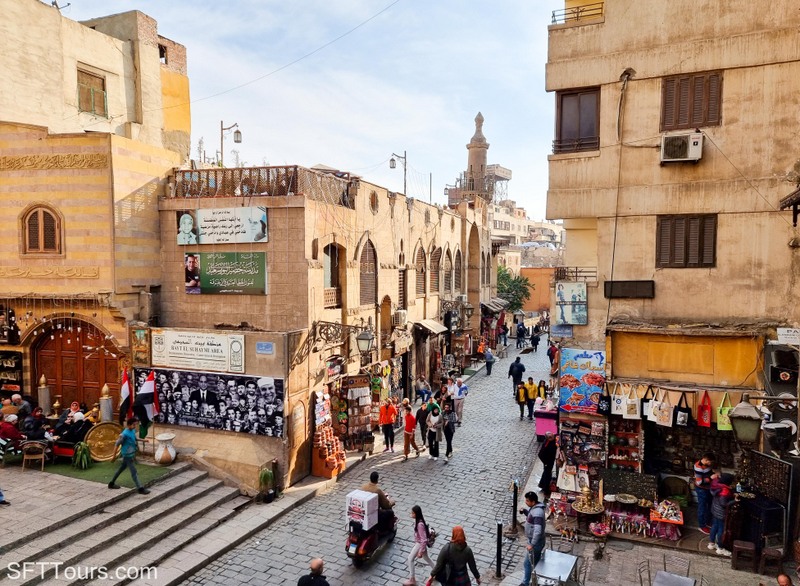
Looking at the above, you can see that temperature variation from night and day meaning you are best to pack in layers to make you sure are prepared for any weather.
It is also important to bring appropriate footwear that will keep you comfortable throughout your trip as you walk on uneven surfaces, ramps, rocks, dusty paths and sand, because that is the makeup of all the Egyptian archeological sites.
Note: Click here to see all our item recommendations in one place on our Amazon Storefront.
Pack light
I am not saying this lightly (pun intended) but you really want to pack light for this trip. Any trip to Egypt includes a fair bit of moving around, packing and unpacking, and changing hotels.
A good rule of thumb is: If you cannot lift your suitcase, it is too heavy.
Pack smart, bring only what you need and repeat outfits, nobody will think less of you and most hotels have laundry if necessary. The dryness in winter and the temperatures, mean that you are not going to be sweating a lot. You can wear the same pair of trousers twice and you can bring more base layer tshirts so that you can rewear sweaters and outer layers more often.
Pack a capsule wardrobe of clothes that all match with each other in colors and styles and you will maximize the outfits you can wear.
Egypt is a very casual destination where being comfortable for the hours of exploration under the sun should trump style, so pack smartly and don’t bring several outfits per day, on most days there will be no occasion to dress up or get changed.
Footwear for the archeological sites
Every single monument, temple and tomb in Egypt will have well laid paths to walk through, though these are often uneven, made of ancient rocks that can be slippery and above all, dusty.
This means comfortable, sturdy, closed-toe and nimble footwear is essential to navigate these sites. High heel shoes or open sandals such as flip flops are not recommended because your feet can end up being hurt, you could be stepped on by other tourists (yes, many of the sites are really crowded) and you will get pretty dirty with all the dust.
Layer up
I’ve said it already but the daily temperatures will change a lot through the day and through the trip, so wearing layers is a must.
In the morning you may need a light scarf and a jacket but as soon as mid morning comes and the sun is shinning, temperatures will increase a bit and you could feel most comfortable in short sleeve tshirt.
Start with a base layer t-shirt or blouse, and top it off with a sweater, cardigan, or light jacket and a scarf for the coldest days in Siwa. You can leave the layers you will not need in the bus on the days when we are moving a lot, but better bring more than miss a layer and be cold.
Be respectful to the local culture
Egypt is a majority muslim country and locals dress conservatively. If you want to blend in, you should leave the short shorts and the mini skirts and spaghetti straps at home.
I also prefer to wear long sleeves because I don’t like having to lather on sunscreen all the time so long sleeves help protect my skin from the sun rays. There is no shade or trees anywhere at the main sites so the sun is always shining on you.
During our trip, we will not be entering many mosques as the majority are reserved for muslim prayer, but we will visit a couple where covering shoulders and knees is required.
Casual rules
As mentioned before, you should prioritise being comfortable over fashionable but there are a couple of occasions where dressing up is possible if you wish to, especially for our Welcome and Farewell dinner, on New Yer’s Eve and during afternoon tea in Aswan.
What to pack for a trip to Eypt in winter
Now that you understand the weather and the local culture when it comes to dress code, let’s take a look at some items we recommend packing for a trip to Egypt.
Long dresses and skirts
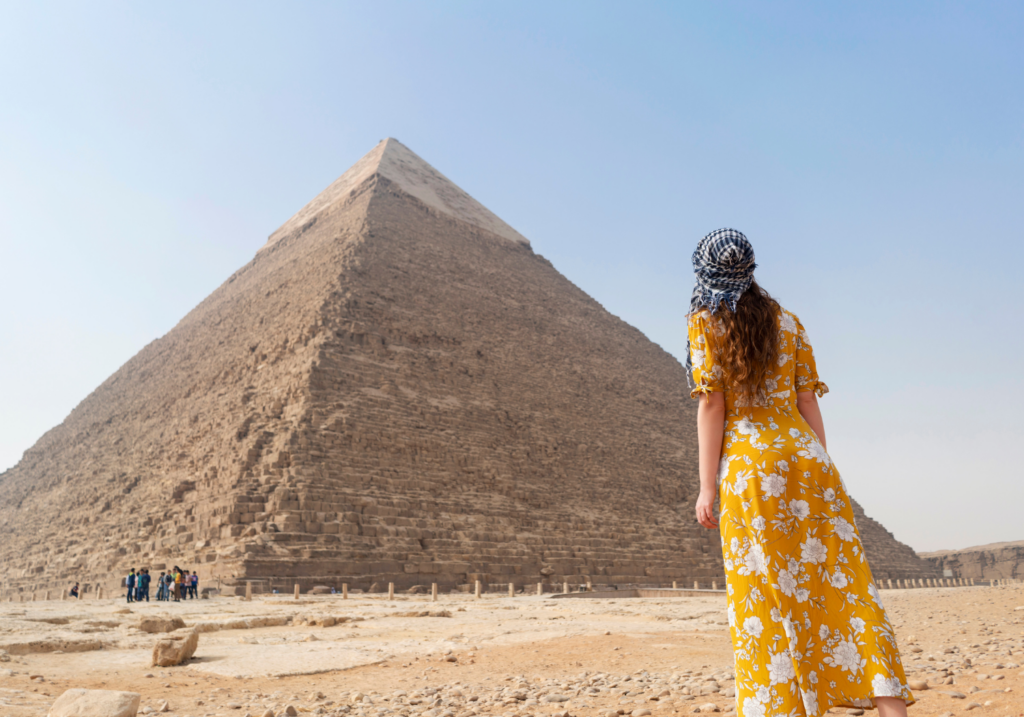
Long dresses or skirts, or those that cover you below the knee, are useful and comfortable and can help you go from day to night when paired with a long cardigan or jacket. They look sleek and can be very classy while remaining conservative.
I like this comfy long skirt and all the skirts and dresses from Chic wish, I have a few of them!
Denim trousers
Denim jeans can be quite useful in winter in Egypt. They are versatile and sturdy, don’t need ironing, pair with anything and can easily work for day or night if accessorised properly.
I would however not recommend wearing them on the longer driving days as they may not be the most comfortable.
Stretchy or loose pants
Remember when I said we would spend quite a lot of time in a bus from Aswan to Luxor and to Siwa Oasis? That’s right, we will be traversing the country and the only way to do that is on wheels.
Sitting down for long periods of time can be quite uncomfortable if you are wearing jeans or other restrictive trousers so a pair of stretchy or loose pants will come in handy. Even yoga pants/leggings are a good idea for these cases.
Tunic + leggings
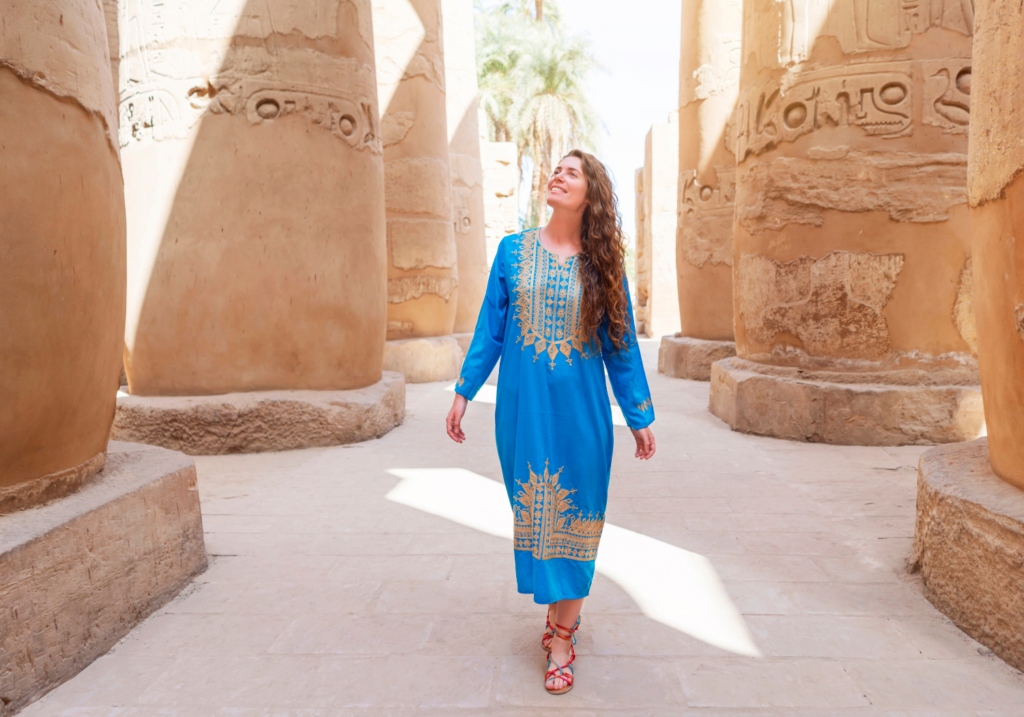
Another great combo for Egypt that is also very commonly worn by the local women are leggings that are layered with a colorful tunic, or even a short dress or oversized shirt.
This is comfortable, adequate for the local culture and can be pretty fashionable. They will also keep you warm as they are layered so you can wear your favorite summer dress but with a pair of leggings underneath.
An anti-theft bag
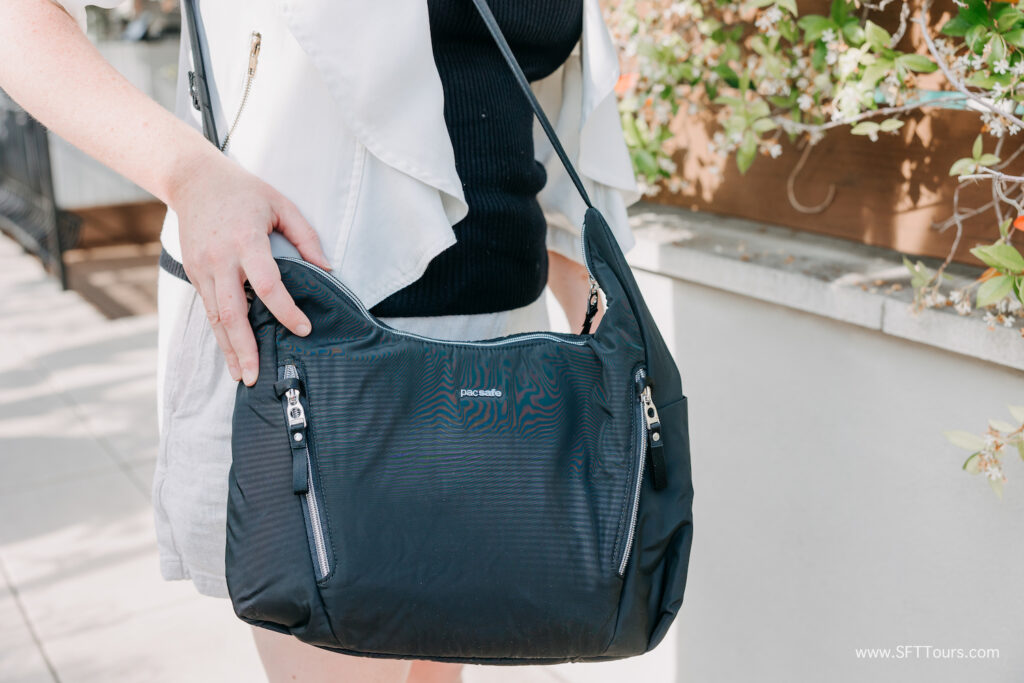
Egypt is a generally safe country when it comes to crime, although harassment is a commonly raised issue among women in particular.
The constant peddling in the markets, the pushy street vendors in the souks and the crowds can be overwhelming even for the most well traveled, and it is almost impossible to spend a day at any of the temples or sites and not be approached by a constant stream of people selling things.
Although crime is low, distractions are many and pick pocketing a risk that is easy to avoid with an anti-theft bag. Always stay alert and keep your belongings safe with one the many bags that have been designed for these specific type of situations.
Slash-proof, anti-theft bags are designed for extra safety. Alternatively, a cross-body bag that is always zipped and in front of you should work.
There are so many easy targets available in crowded places that, as soon as you make yourself a more difficult one, you raise the barrier for the average thief. Below are some of the best anti-theft bags.
A light jacket
You already know the weather forecast and the temperature ranges so a jacket needs to be included in your packing list.
This does not need to be a winter jacket because it will only come in handy in the late evening or early mornings, so you may have to carry it around when the temperatures warm up as the day progresses so bring something that is easy to carry.
A fluffy fleece like this one or even a thick cardigan may be the best alternative. If you like it more stylish, a denim jacket can also work, though it’ll be heavier to carry around.
A scarf
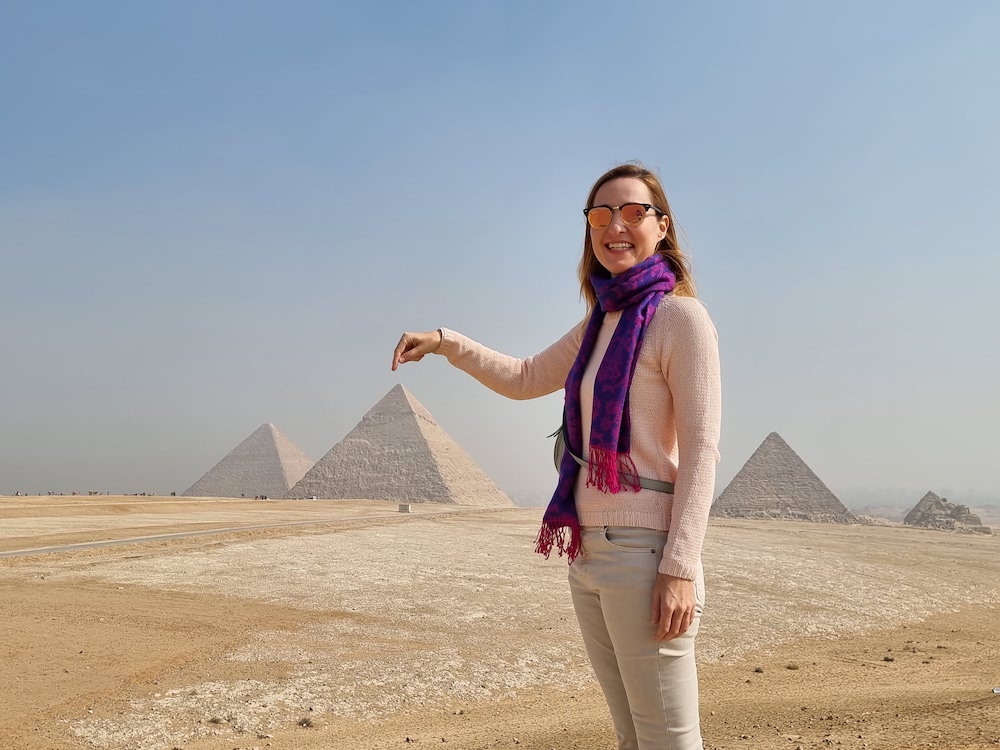
Although we will not be entering too many religious buildings, it pays to have a scarf handy in case we get the opportunity to enter a place of worship.
A scarf can also come in handy in the plane, when they crank up the AC, or in the evenings when the temperatures drop, especially in Siwa, to complement a lighter jacket.
A couple of cute evening outfits
We always like to celebrate the start and end of our tours with a lovely dinner when a cute outfit will come in handy.
This dress is a nice option you could dress up or down while staying modest. This one is also a great option. Like I said before, long skirts are also a versatile option to go from day to night. A pair of sandals like these would also be perfect.
On New Year’s Eve expect people to dress up. This is the chance to wear something nice that makes you feel free and you want to enter the new year in.
Comfortable closed toe shoes
I mentioned it above, a pair of comfortable shoes is essential for walking on uneven surfaces of all the sites. Something that is sturdy, that you can be in for hours, and that has grip is best.
Expect to walk at least 10,000 steps a day across temples, dusty paths, sand from the desert, and rocky paths, so your footwear is the most important element to consider.
You can wear a pair of cute sneakers, walking ballerinas, etc. Here are a few options I wear or have seen our guests wear on our tours:
- Sketchers Bob’s cute sneakers are good for walking and comfortable, but not chunky.
- Classic Lacoste sneakers that can be preppy cute even with a dress.
- A pair of Converse always a classic.
- Super comfy pair of ballet flats.
- Superga, an all-time favorite pair of walking shoes, now in cure pastel colors.
- My comfortable travel shoes I have been wearing on every trip for the last 2 years. These ones go from day to night because I have the golden ones. To be honest, I would not wear a new pair to Egypt because they could be ruined, unless they are your dress-up pair.
- Birkenstock sandals that are made for walking.
- These Dr. Scholl’s sneakers are definitely our choice for class, versatility and comfort.
For the evenings or to dress up, you could wear a pair of cute flats or ballerinas or bring a pair of platform shoes. You will most likely be in a restaurant or hotel for dinner so the uneven surfaces are no longer an issue.
Other things to pack for Egypt in winter

Besides clothing, there are a few other things worth packing as a solo female traveler for your trip to Egypt in the winter.
- Swim suit: If you plan to spend time by the Red Sea you will need a bikini or swim suit. If you are going on a Nile River cruise, some of the higher end ones have outdoor heated pools or jacuzzi and the hotel we stay at in Aswan (Movenpick) also has an outdoor heated pool.
- A sun hat or cap: There is practically no shade at all and no trees at any of the archeological sites in Egypt and that means that you will be standing under the sun for a few hours a day. A hat / cap or head cover of sorts can come in quite handy. Check out this wide brim one.
- A supportive bra: We will spend some time on bumpy roads, a good bra to keep it all in place is a good idea.
- Universal plug adaptor: Egypt uses standard three-prong flat UK plug so bring an international adaptor to plug all your electronics. I like the ones which come with USB ports so that I can charge phones, cameras and everything else with just one adaptor. I love this one because it has USB ports for all the electronics at the same time.
- Power bank: Because the days will be long and you will use your phone a lot to take photos of everything, a power bank will ensure you can continue taking photos. The INIU Portable Charger has a 20000mAh capacity, and fast-charging USB-C ports, you can power up your devices in a flash, while the LED display keeps you in the know about your battery level.
- Sunglasses: I expect sunshine galore so a pair of sunglasses is an essential travel item. I like and wear Oakley sunglasses as they are polarized and protect your eyes from any damaging sun rays. I alway wear them. Yes, they are not fashionable, but I have sensitive eyes that don’t like bright days, so they are a lifesaver for me.
- Water bottle: Single use plastic bottles are terrible for the environment so we recommend you bring your own reusable bottle as part of our efforts towards zero-waste and responsible travel. Tap water will not always be safe to drink but you can replenish your bottle at breakfast.
- Sunscreen: Perhaps the most important item in this packing list is sunscreen. Living in the tropics, this is an everyday item for me I never leave the house without. This one has amazing reviews on Amazon.
- Lip balm: The sun and dryness of the desert makes it particularly tough for the skin and lips so you should bring a lip balm to stay moisturized. We find these are essential to not end up with completely ruined lips or even blisters. This Nivea one comes in a pack of 4 and has SPF, so your lips will never be dry again!
- Sleep mask: Although hotels have proper blinds, you will be sharing the room with another traveler who may be a late owl. I strongly recommend Manta Sleep mask and I travel with it, and wear it in the plane, for several months now. It is incredibly good at blocking sound and light and at helping with jetlag. One of my most important travel must-haves (PS I have the one with sound incorporated and the one with the cold / warm eye pads).
- Pajamas: As mentioned, you will most likely be sharing a room so don’t forget to pack your pajamas! Meg has these ones.
- Ear plugs: It is never a bad idea to have a pair of earplugs handy, for the flight, a noisy neighbor or an antsy roommate.
- First aid kit and medication: Available medications, brands and products in Egypt may not be the same as back home, so it’s always best to bring everything you are used to and of course, all prescription medication or vitamins you take. We also recommend packing a basic first aid kit with items such as plasters, an antiseptic ointment, eye drops, hydration powder, etc. We’ll spend time in a car on extremely windy roads so motion sickness medication is a good idea if you are prone to getting it. Have a look at our suggested first aid kit here.
- A pair of flip flops: If you are going to spend time by the Red Sea, a pair of flip flops or sandals will come in handy for poolside lounging or beach time. I have been wearing Havaianas for decades and like these silver skinny ones.
- Tissue paper: Many toilets in Egypt don’t have toilet paper so it’s always best to bring your own.
- Antibacterial wet wipes or soap: Toilet paper is not commonly available and the same applies to soap. Having your own wet wipes will come in handy when eating at casual eateries or stopping at toilets. They are also useful to wash your hands from the constant dust. I always keep a packed of these ones.
- Sanitary products: Egypt may not have the product or brand you like to use, may not stock things like tampons, or we may not be near an urban center where larger supermarkets are available, so it’s best to bring your own with enough amount for the duration of the trip.
- A “just in case” tote bag: You are going to shop in Egypt, likely a lot. When I know I will be shopping, I always bring my packable Just in case Tumi bag. It packs tiny when not used and expands to a large tote bag where I can fit all my shopping. Alternatively, canvas tote bags like this do the trick without breaking the bank.
- Electrolytes or rehydration tablets: Maybe the fact that toilets aren’t great or that the weather is rather dry make you drink far less than usual so you end up having a headache, the first symptom of dehydration. I like to bring these hydrating tablets from Nuun with me, always. They come in handy if you are somewhere dry, like the desert, or if you end up with travelers’ diaorreah where the risk of dehydration is high.
What not to pack for Egypt
There are also a few things we do not recommend you bring to Egypt, mainly, because you won’t need them.
- Revealing clothes: This goes for short shorts, miniskirts, mini dresses, tops which show cleavage, tank tops, crop tops, etc. all these you are best to leave at home.
- Hair dryer: Most hotels have them and if yours is old, you’ll also need to carry a converter or make sure it works with double voltage so that it does not get fried by the 220V.
- Hand bags that don’t close: You know the ones, the basket-style ones that don’t have a zipper to close them are a big no-no in the crowded tourist attractions and souks, unless you want to make pickpockets happy.
- Hiking boots: Yes the archeological sites are are all uneven and dusty, but a pair of hiking boots is an unnecessary overkill. Leave them at home.
